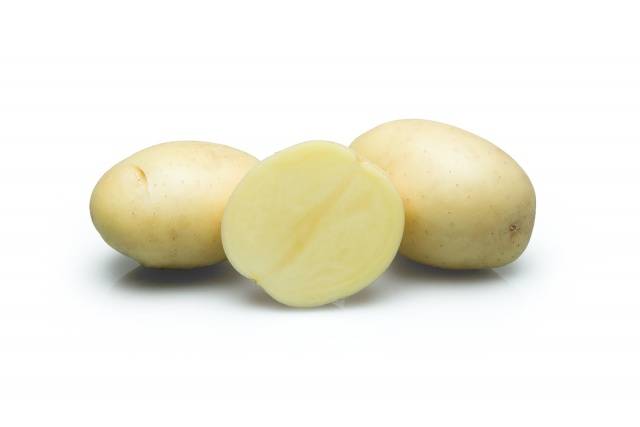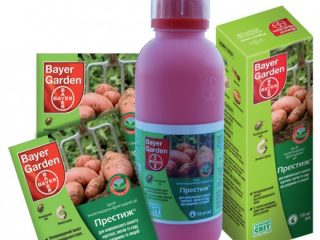Content
The new Labadia variety is gaining popularity based on its characteristics. The rapid development period, large, beautiful root crops, immunity to a number of dangerous diseases make the variety in demand.
Origin story
The Labadiya variety was bred in the Netherlands and has been included in the State Register since 2010. Originator: Stet Holland B.V. Potatoes of the Labadiya variety are recommended for growing in the conditions of the central, Ural, Volga and southern regions of Russia.
Description and characteristics
Growing season | 75 days before ripening, technical ripeness phase in 105-115 days |
Aboveground part | The stems are tall, the bush is vigorous, straight or semi-spreading. The leaves are large, slightly wavy. Corollas medium or large, white |
Tubers | Oval, oblong; eyes small/medium recessed |
Peel | Smooth/slightly rough, thin, yellow |
Pulp | Light yellow, with a dense structure |
Starch content | 12,2-16,4% |
Dry matter content | 20,7-21,3% |
Weight | 100-150 g |
Product output | 89-95% |
Quantity in slot | 6-9 pieces |
Productivity | 290-460 c/ha, maximum – 583 c/ha |
Rest period during storage | 97% |
Features of the growing season | Drought resistance, adaptation of the variety to different types of soil |
Disease resistance | Immunity to potato cancer and wrinkled mosaic, golden nematode infection. The variety is moderately susceptible to leafroll virus, banded mosaic and late blight. |
The mid-early table variety Labadia has a good taste and, after cooking, retains a pleasant creamy-yellow hue. Labadia is used for baking, frying, French fries, chips, since according to the European classification of table varieties it belongs to group “B” - slightly mealy, universal. When cooked in water, the potatoes will soften a little.
Advantages and disadvantages
Advantages | Flaws |
Excellent commercial properties: large, one-dimensional tubers, light, slightly rough skin texture; keeping quality and transportability | Tubers planted without light sprouts germinate slowly. Mandatory germination period |
Pleasant taste | Do not plant early in cold soil |
High stable yield | Prone to external mechanical damage, but the dense structure remains without flaws |
Tolerates drought. Adapts to different soils |
|
The variety is resistant to dangerous potato diseases |
|
Landing
Growing Labadia potatoes will bring a stable harvest from all types of soil. In terms of acidity, soil with a pH reaction of 5.1-6.0 is better suited. Without a laboratory, you can approximately determine the acidity of a potato site. If there are daisies, clover, dandelions, wheatgrass, coltsfoot, potatoes will also bear fruit well. In autumn, the soil is enriched with manure, bird droppings or superphosphate, potassium mixtures, and ammonium sulfate.
In the southern regions, the Labadia variety can be grown 2 times per season if the correct agricultural practices are followed.
- Germination in light takes 20-30 days. Without sprouts, the seed takes a long time to awaken.
- Before planting, it is advisable to treat potatoes with growth stimulants.
- Labadia potatoes are placed according to a 70 x 35 cm pattern.
- They are planted in soil that has warmed up to +8°C to a planting depth of 8-10 cm. If the recommendations are followed, the shoots will be uniform and friendly.
Care
Despite all the unpretentiousness of the Labadia variety, it needs to be carefully looked after.
- The area with potatoes is regularly loosened, providing the root system with sufficient air access, and remove weeds;
- When it rains, water only before the flowering phase, then the crop especially needs moisture;
- In dry season conditions, watering is important when the stems reach a height of 6 cm, then before and after flowering;
- Up to 50 liters of water are used per square meter to moisten the layer of soil where the tubers develop.
Hilling and feeding
Vigorous Labadia potato bushes are hilled high so that the large tubers that are forming do not turn green in the sun. The first hilling is carried out when the stems are 12-15 cm high. The next one is done after 2-3 weeks. Hill up for the last time before flowering.
The Labadia potato variety needs to be fed even on fertile soil.
- They begin to fertilize potatoes when the plants reach a height of 15 cm: 5 g of urea are dissolved in 10 liters of water and 0.5 liters are poured under the bush.
- Infuse manure or chicken droppings: 500 g per 10 liters of water. Then the infusion is diluted 1:10 and watered between the rows.
- Before flowering, dissolve 200 g of wood ash or 20 g of potassium sulfate in 10 liters of water. Water 0.5 liters under each bush.
- During flowering, to activate the formation of tubers of the Labadia variety, potatoes are fed with a solution of 20 g of superphosphate in 10 liters of water. You can also add a solution of mullein or bird droppings. Consumption – 0.5 l at the root.
Diseases and pests
Diseases/pests | Signs | Treatment |
Late blight | Dark spots form on the stems and leaves, later a gray coating. In rainy weather and temperatures below +15°C, the fungus spreads throughout the entire area in 10 days | Labadia potatoes are treated prophylactically with fungicides Baktofit, Arcerid, Quadris and others. Healthy tubers are selected for planting |
Scab | Only tubers are affected. Brown or black cracks with rough edges form on the peel. The fungus develops at high temperatures. Starchiness is significantly reduced | The fungus persists in the soil for more than 3 years. Planting potatoes are treated with Fito Plus. They also spray potato bushes during the growing season. |
Brown bacterial rot of potatoes | When the plant blooms, the tops begin to fade, the leaves turn yellow, and the veins at the bottom of the stem are affected by rot. Tubers rot during storage | Potatoes cannot be planted on the affected area for 5 years. Planting tubers are heated for germination, and then sorted, removing the affected ones. Spray with Baktofit before planting and twice before flowering |
Potato moth | Butterflies, similar to clothes moths, flutter over the bushes if you move them. The plant and tubers suffer from small larvae - 1-1.3 cm. With a large infestation, the moth may have time to lay eggs in the tubers that are closer to the surface | Insecticides. High hilling is carried out, which is required according to the technology for the Labadiya variety. |
Harvesting
7-10 days before harvesting potatoes, green or yellowed stems are mowed down, the tubers are covered with a thick peel. The dug up potatoes are ventilated and dried in dark rooms. Tubers are stored for storage without damage.
Conclusion
The mid-early table variety is distinguished by an abundant harvest and large tubers, suitable for cultivation on private farms and for large-scale agricultural sector. The variety's resistance to pathogens of viral diseases and the golden nematode, its unpretentiousness to soils will serve to popularize it, as will its versatility in use.













